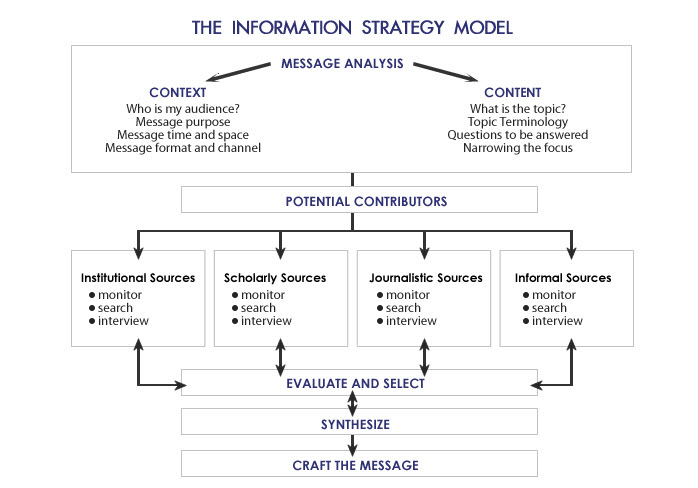2.2 The Information Strategy Process
Models can be useful ways to illustrate often complicated processes. The Information Strategy Process model below recognizes that in an information-rich environment, it is impossible to remember thousands of specific information-finding tools and resources for answering specific questions. Instead, the model suggests a systematic course to follow when developing a strategy for determining, and seeking, the information needed for any message type or topic.
The model identifies the steps in the information strategy process and indicates the paths between the steps. As the two-way arrows indicate, the process may include some backtracking in the course of verifying information or raising additional questions. As a graphic representation of both the steps to take in the process and the sources that might meet a particular information need, the model serves as the outline of your entire information-gathering process.
The model also identifies the contributors to an information strategy. Information is created by many different types of sources and is intended to meet a wide variety of needs for both the information creator and for anyone who might gather and use that information. The model points out the major contributors or sources of information: institutional sources (which includes both public-sector and private- sector institutions), scholarly sources, journalistic sources and informal sources. We will discuss each of these in more detail in Lesson 6 and in other Lessons where appropriate.
The information strategy model for mass communicators applies to any type of message task and any topic that you may be working on. The process applies to an information search for news, advertising, public relations or even for an academic paper. The information strategy process can facilitate the search for information on any topic and for any audience.
For mass communicators, the information strategy process will help you:
- think through the message’s purpose, context, audience and key topics
- identify and select a manageable portion of the topic which needs to be examined
- develop a method for in-depth examination of a segment of the topic selected
- identify appropriate potential sources of information
- select effective techniques for researching the topic
- determine a vocabulary for discussing your message analysis, information gathering and selection process with others (colleagues, supervisors, critics, audience members. etc.)
- save time by helping you avoid wading through masses of information that may be interesting, but in the end, not very useful for the message task
We will use this conceptual map as a way to think about how to accomplish each of the information tasks that communication professionals might face.


